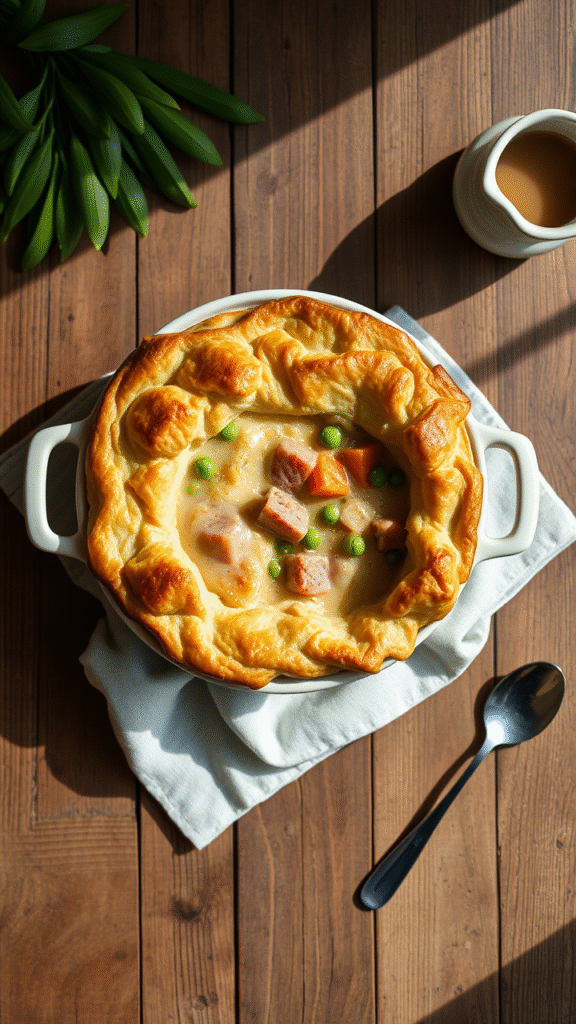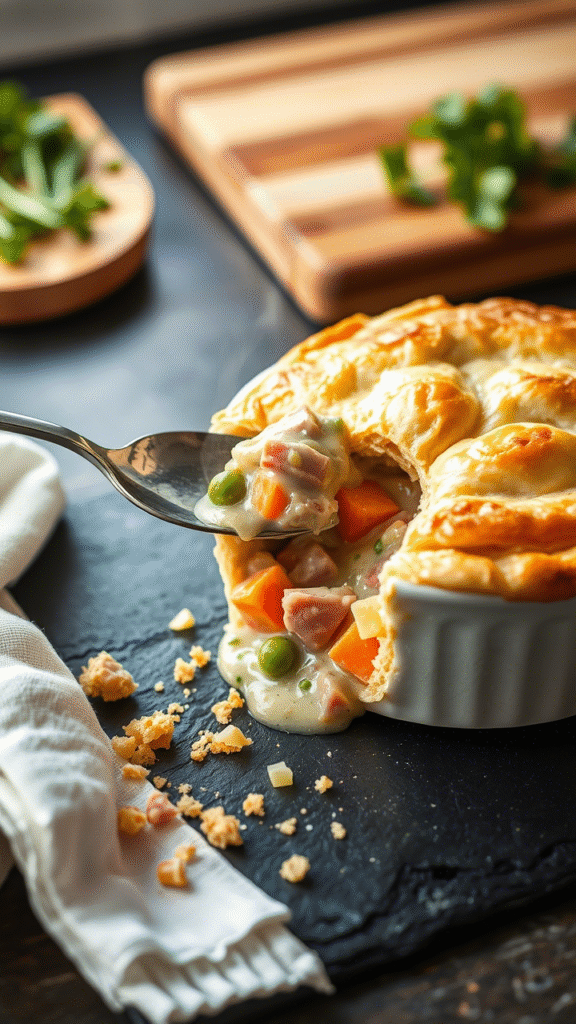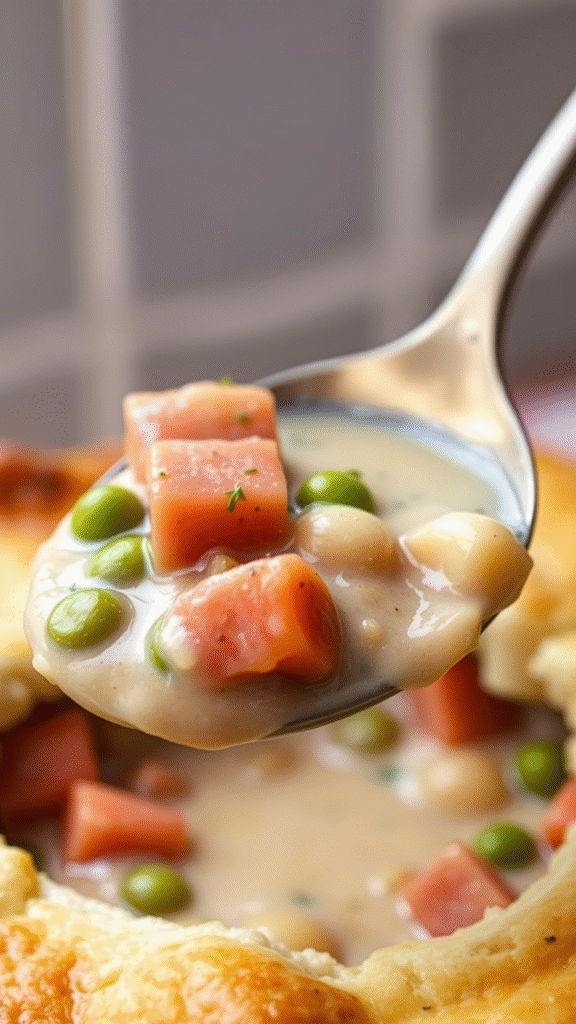Ever had a dish that instantly wrapped you in a warm, cozy hug? That’s exactly what a ham potpie does. It’s not just some run-of-the-mill comfort food; it’s a heritage dish that whispers stories of home kitchens and weekend family feasts. But here’s the kicker—when done right, ham potpie isn’t just nostalgic; it’s a showcase of technique and ingredient magic that even seasoned chefs admire.
Ham potpie is a savory pie featuring tender, smoky ham enveloped in a luscious creamy filling, all under a flaky, golden crust. What makes it special? It’s the marriage of textures and flavors—the way the saltiness of the ham plays off the buttery crust and the velvety sauce binding it all. Plus, it’s versatile. Ham potpie is a canvas for creativity, inviting fresh herbs, root veggies, or even a spice kick. It carries a cultural nod to rustic, no-fuss cooking that transforms leftovers into culinary gems.
Ingredients & Substitutions
When you break down a ham potpie, the ingredients list looks straightforward—but trust me, picking the right ones makes or breaks it.
- Ham (about 2 cups diced): Use good-quality smoked ham. Avoid overly salty pre-packaged stuff; it’ll overwhelm. For a leaner twist, smoked turkey works well, but you lose a bit of that deep ham flavor.
- Flour (all-purpose, ¼ cup): Vital for thickening the sauce. High-protein flour (bread flour) isn’t recommended here—it makes the sauce gummy. All-purpose’s got the perfect starch-protein balance.
- Butter (4 tbsp): Real butter, none of that margarine nonsense. It adds richness and helps with browning.
- Milk or cream (1 ½ cups): Cream makes the filling luscious, but whole milk is a good swap if you want it lighter.
- Onion (1 medium, diced): Fresh onion is crucial for that sweet pungency. Dried onion flakes can be used in a pinch but won’t give the same punch.
- Carrots and peas (½ cup each): These add sweetness and color. Frozen peas are fine; fresh is ideal for texture.
- Herbs: Thyme and parsley (fresh preferred): Fresh herbs bring a brightness that dried can’t replicate here, but if you’re stuck, dried thyme at half the quantity works.
- Pie crust: Homemade is ideal. A flaky, buttery crust made from pastry flour is heaven. Store-bought works, but skip anything labeled “all-butter” if you want the authentic flakiness; they often add shortening which changes texture.
Ingredient insights
The ham’s saltiness influences how much seasoning you add later—taste as you go. Using fresh herbs right at the end preserves their fragrance. Also, using cream versus milk shifts the whole mouthfeel—cream gives that silky, indulgent vibe, but milk keeps it humble and hearty. Flour quality? All-purpose is the unsung hero here; it thickens without turning gummy or chalky.
Step-by-Step Instructions

- Prepare the Filling: Melt butter over medium heat in a heavy-bottomed pan. Add onions, cook till translucent, about 4 minutes. Don’t rush or burn—burnt onions will make the whole potpie bitter.
- Make the Roux: Sprinkle flour over the onions, stir constantly for 2 minutes. This cooks the raw flour taste away. Expert tip: Stirring is non-negotiable here; lumps spell disaster.
- Add Liquid: Gradually whisk in milk or cream. Keep whisking to avoid lumps. Let the sauce thicken gently—don’t let it boil hard, or the sauce can split.
- Incorporate Ham & Veggies: Fold in diced ham, carrots, peas, and herbs. Season lightly. Remember, ham brings salt, so go easy on salt until you taste.
- Assemble: Pour filling into a pie dish. Cover with pie crust, seal edges with a fork or your fingers, and cut a few slits to vent steam.
- Bake: Preheat oven to 375°F (190°C). Bake for 35-40 minutes, or until crust is golden and sauce bubbly. Avoid opening the oven too soon; this can collapse the crust.
Common mistakes & fixes
- Lumpy sauce? Whisk thoroughly when adding liquid, or strain if too stubborn.
- Soggy crust? Blind bake the crust for 10 minutes before filling or brush with egg white to seal.
- Over-salted filling? Dilute with a splash of milk or add more veggies to balance.
Variations
- For a spicy kick, toss in cayenne or smoked paprika.
- Add mushrooms or leeks for earthiness.
- Use sweet potatoes or parsnips instead of carrots for a sweeter dimension.
Cooking Techniques & Science

Why start with a roux? This classic thickening method is gold for creamy fillings. The fat from butter coats the flour proteins, preventing them from clumping and creating a smooth base. When you add milk slowly and whisk, you get a sauce that’s silky, not grainy.
The ham is pre-cooked, so we add it late to avoid drying it out. Ham’s saltiness means the filling rarely needs extra salt, but you gotta taste anyway.
Baking the pie creates a Maillard reaction on the crust edges—this caramelization is what gives you that nutty, toasty aroma. That crispy contrast against the creamy interior is what keeps people coming back for more.
A good pie crust is crucial. Using cold butter and minimal handling prevents gluten overdevelopment, keeping it flaky instead of tough. Pastry flour has lower protein than all-purpose, meaning less gluten—this gives you that tender, melt-in-mouth texture.
Serving & Pairing Suggestions

Ham potpie is hearty enough to stand alone but shines paired with crisp, acidic sides.
Try a simple arugula salad tossed with lemon vinaigrette to cut through the richness. A glass of dry white wine, like a Sauvignon Blanc, brings brightness. For a non-alcoholic option, a sparkling apple cider adds a festive touch.
Presentation-wise, a rustic, browned crust with a sprig of fresh thyme on top makes a stunning centerpiece. Serving it straight from the oven with a ladle and generous platefuls of steaming potpie invites cozy communal eating.
Conclusion
Ham potpie is comfort elevated by technique. It’s the creamy, savory filling, the flaky crust, and that whisper of smoky ham that elevates leftovers into something spectacular. Using the right ingredients and respecting the steps—especially the roux and crust—makes all the difference.
Final pro tip: Don’t rush the sauce thickening; patience here ensures velvety texture. Experiment with herbs and veggies to make it your own. Trust me, once you nail this classic, it’s gonna be a staple in your recipe arsenal for years.
FAQs
Q1: Can I make ham potpie ahead of time?
Yes, prepare the filling and store it refrigerated, assemble and bake just before serving to keep crust crisp.
Q2: What’s the best way to store leftovers?
Cover and refrigerate for up to 3 days. Reheat in a moderate oven to preserve crust texture.
Q3: Can I use a gluten-free flour?
Yes, but choose a blend designed for thickening sauces. You might need a bit less or more liquid to get the right consistency.
Q4: How do I prevent the crust from getting soggy?
Blind bake the crust briefly or brush with egg white before adding filling. Also, ensure filling isn’t too watery.
Q5: Can I freeze ham potpie?
Absolutely! Freeze unbaked for best results. Thaw overnight in fridge and bake as usual.

Food lover, recipe creator & the heart behind NoshCrafters.com. Olivia shares mouthwatering, easy-to-make dishes that turn everyday meals into unforgettable bites. When she’s not experimenting in the kitchen, she’s busy plating up inspiration for home cooks everywhere.